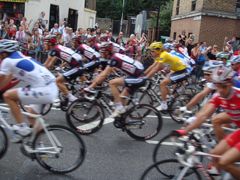Since spending several of my working weeks in London, the biggest change I notice between here & home (Edinburgh) is the pollution. The air is so thick that you can almost drink it in as opposed to breathing. This was an immediate concern of mine, particularly as I had fully hoped to adhere to a promise I made to myself as a new graduate, insisting that I would never commute more than 30 minutes to work unless it involved running or cycling.
The European Society of Cardiology posted the following article in relation to a study conducted among cyclists in Copenhagen, Denmark, by Dr Peter Schnohr, showing that it is the relative intensity & not the duration of cycling which is of most importance in relation to all-cause mortality & even more pronounced for coronary heart disease mortality:
The study presented today at the ESC Congress 2011, concluded that men with fast intensity cycling survived 5.3 years longer, and men with average intensity 2.9 years longer than men with slow cycling intensity. For women the figures were 3.9 and 2.2 years longer, respectively (see Figures below). The groups were adjusted for differences in age and conventional risk factor levels.
Current recommendations prescribe that every adult should accumulate 30 minutes or more of moderate physical activity in leisure time, preferably every day of the week. The optimal intensity, duration and frequency still have to be established.
According to Prof Schnor, “this study suggests that a greater part of the daily physical activity in leisure time should be vigorous, based on the individuals own perception of intensity. “Our group has already published similar results for all-cause mortality in relation to walking.”2
The following tables show hazard ratios for all-cause and coronary heart disease death in relation to duration and intensity of cycling adjusted for age, gender, number of other sports activities, BMI, systolic blood pressure (including antihypertensive medication), HDL-cholesterol, smoking, income, alcohol-intake and diabetes. Within all three duration groups, there was an inverse association between cycling intensity and all-cause mortality, this was even more pronounced for coronary heart disease.
Figure: Multivariate-adjusted survival benefit for a normal weight person, without diabetes mellitus, systolic blood pressure under 140 mmHg (and no use of antihypertensive medication), mean value of HDL-cholesterol, current smoker, income above average, has fewer than 21 drinks per week, and with one other sport activity. The reference person is one that in addition to these criteria rides a bicycle slowly (red) or less than 0.5 h/day (green).


Contributors:
Jacob L. Marott, Jan S. Jensen, Gorm B. Jensen
1 Supported by grants from The Danish Heart Foundation.
2(Schnohr P et al. Intensity versus duration of walking: Impact on mortality: the Copenhagen City Heart Study. Eur J Cardiovasc Prev Rehabil 2007;14:72-78).

